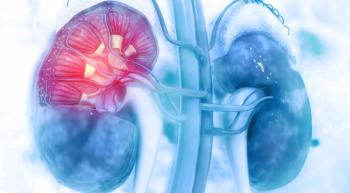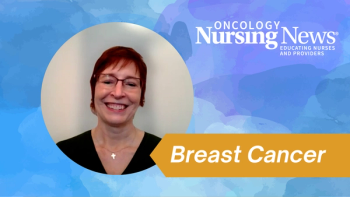
- February 2014
- Volume 8
- Issue 1
Supporting the Support System- Meeting the Needs of Family Caregivers
Laurel Northouse's interest in supporting the family caregivers of patients with cancer began nearly four decades ago when the young BSN graduate became a caregiver herself at the age of 27, following her husband's diagnosis of Stage IV Hodgkin's Disease
Laurel Northouse’s interest in supporting the family caregivers of patients with cancer began nearly four decades ago when the young BSN graduate became a caregiver herself at the age of 27, following her husband’s diagnosis of Stage IV Hodgkin’s Disease. He is doing well today and has run 21 marathons since being diagnosed, despite being told at the time that he had only 10 years to live. For Northouse, the experience fueled a career-long interest in how caregivers cope with a loved one’s cancer diagnosis.
“The amount of stress caregivers have is similar to the patient’s,” she told her audience at the ONS Connections Conference. Northouse, RN, PhD, FAAN, is the Mary Lou Willard French Professor of Nursing at the University of Michigan School of Nursing in Ann Arbor and recipient of the 2013 ONS Distinguished Researcher Award. “Caregivers have existed over time, but with so many treatments that are helping people to live longer with their serious illness, that care is now going on in the home,” where, she added, patients have complex care needs and medication regimens that caregivers—many with comorbid conditions of their own—may feel unprepared to manage.
Laying the Groundwork
In researching her doctoral dissertation in the 1980s, Northouse said she was struck by the lack of family-focused research. At the same time, she said, a “Conspiracy of Silence” often surrounded a cancer diagnosis, whereby family members would be informed of it, but not the patients themselves. “Families were viewed as innocent bystanders and thought to be immune to the effects of cancer,” said Northouse. The focus shifted in the 1990s, when the President’s Cancer Panel began to address issues connected with survivorship, and Northouse credits the work of oncology nurse researchers in expanding those previously patient- and survivor-centered discussions to also encompass the needs of cancer patients’ spouses and other family caregivers.
With more individuals surviving cancer, researchers also saw a need for longitudinal studies to discern how long the distress of a cancer diagnosis might last. In 1998, Northouse and colleagues conducted a study comparing the adjustment period for women with breast cancer or benign disease with the adjustment experiences of their husbands.1 They found that couples facing breast cancer reported lower levels of marital and family functioning, and that those couples who reported high distress when the patient was diagnosed were more likely to continue to be very distressed at 2 months and 1 year after diagnosis—suggesting a need for clinicians to help not only the patient, but also her spouse, in managing adjustment difficulties over time.
Surveys show that the vast majority of patients with cancer fear that their cancer will come back, noted Northouse, and fear of recurrence can be ‘contagious’ in families. When researchers looked at that issue, in fact, they found that caregivers often report more fear: patients’ fear of recurrence score was 67, whereas caregivers scored 73 (P <.0001).2
At first glance, this finding was surprising, Northouse said. Yet, “if you think about it, the family members are often left in the waiting room. They don’t have as many conversations with health professionals to ask their questions. They have a lot of uncertainty.”
Clinical Pearls—Caring for the Caregiver
- Treat the patient—caregiver dyad as a unit of care
- Document presence and preparation of caregiver in the patient’s medical record
- Assess caregivers’ needs for information and support
- Modify survivorship care plans to include caregivers
- Watch for caregiver strain
- Refer dyads to websites with evidence-based information and other community resources
“In every study that I have done since that first one, I’ve measured social support of patients and family members, and family members always report less support.”
Northouse pointed to studies of family caregiver stress conducted by the American Cancer Society which have been influential in fostering much-needed focus on the issue, including its National Quality of Life Survey for Caregivers project, a longitudinal study of family caregivers launched in 2002.3 The findings point to unmet needs in this population, she said, and underscore that family caregivers need help with their own distress as well as that of their loved one. Another study by the Australian Ovarian Cancer Study Group found that more than half of the caregivers of women with ovarian cancer did not meet the country’s health guidelines and reported negative changes in their lives after becoming a caregiver4; negative effects included weight gain, decreased physical activity, and increased use of alcohol.
Focusing on One Unit of Care
Her own understanding of family systems theory prompted Northouse to explore the effect patients and caregivers might have on one another—positing that targeting interventions to patients and caregivers as a single unit of care or dyad would make sense.
Surveys suggest that 70% of caregivers want more information and support from health professionals. In a meta-analysis of 29 randomized clinical trials addressing the needs of family caregivers of cancer patients, Northouse and colleagues found that the majority were directed to both patients and their family caregivers and concluded that for optimal care, interventions need to focus on patient—caregiver units.5
Types of interventions were psychoeducational (eg, providing information on symptom management, as well as meeting the emotional needs of patients and caregivers), skills training (eg, the development of problem-solving and communication skills), and therapeutic counseling to address concerns related to cancer or caregiving. The analysis found small to medium effects from the interventions, including reduced caregiver burden, improved ability to cope, and increased sense of self-efficacy. No effect was seen from the interventions on reducing caregiver depression.5
Northouse has used insights gleaned from her extensive research to inform the development of an intervention for cancer patients and their family caregivers known as FOCUS (Family, Optimism, Coping, Uncertainty, and Symptoms) and studied the model’s efficacy among dyads affected by a variety of cancers, including breast, prostate, lung, and colorectal cancer. In one FOCUS study, patient—caregiver dyads were randomly assigned to receive a brief (3-session) or extensive (6-session) information and support intervention or to a control group. The researchers found that both the brief and extensive programs benefited the dyads in terms of coping and social and emotional quality of life, with most effects found at 3 months.6
Resources on the Web
Research-Tested Intervention Programs (RTIPs) is a searchable database hosted by the National Cancer Institute with information on evidence-based interventions and program materials. For more information on caregiver support, visit the site’s Survivorship Intervention Programs page at
.
Communication is an essential component of the FOCUS intervention, said Northouse, grounded in the understanding that when the partners in the dyad support each other, they can work as a team to manage cancer. When the dyad meets together with clinicians, communication is even better, and Northouse said this three-way communication has been an integral part of their intervention.
“It was powerful to meet with them jointly; they could each hear what the other person had to say in the presence of a nurse who could help clarify information. It eliminated guesswork.” Recognizing each other’s strengths, fostering a positive outlook, cultivating coping strategies, and living with uncertainty are also all part of the mix, along with dealing with symptoms—not only of the patient, but also of the caregiver. Among the clinical implications of implementing dyad interventions are risk (whether they should be delivered only to those deemed “at risk,” and if so, how to screen) and dose (shorter vs longer interventions).
“We found whether the person was high or low risk, they still benefited from the intervention. We also found some differences by dose of the intervention, but people benefited from both the short and the longer intervention, which suggests that we can probably do some of these interventions over a shorter period of time, and it’s less costly to do it that way,” said Northouse. As another way to address not only program costs, but also a shortage of nurses, Northouse and colleagues developed a Web-based program, which can be tailored to different dyad types, such as a married couple, mother/daughter, etc. “We found in our focus groups that the patient and caregiver enjoyed working together on the computer,” said Northouse. The FOCUS program is among those listed on a National Cancer Institute database where visitors can download all of the resources her team has developed for the program. More than 2000 individuals have downloaded program summaries to date. “The message here is that interventions do help. People have distress, but we can offer nursing interventions that can make a difference in their lives.”
References
- Northouse LL, Templin T, Mood D, Oberst M. Couples’ adjustment to breast cancer and benign breast disease: a longitudinal analysis. Psychooncology. 1998;7(1):37-48.
- Mellon S, Northouse LL, Weiss LK. A population-based study of the quality of life of cancer survivors and their family caregivers. Cancer Nurs. 2006;29(2):120-131.
- American Cancer Society. Family Caregivers Research. http://www.cancer.org/research/survivaltreatmentresearch/familycaregivers- research. Accessed January 30, 2014.
- Beesley VL, Price MA, Webb PM. Loss of lifestyle: health behavior and weight changes after becoming a caregiver of a family member diagnosed with ovarian cancer. Support Care Cancer. 2011;19(12):1949- 1956.
- Northouse LL, Katapodi MC, Song L, Zhang L, Mood DW. Interventions with family caregivers of cancer patients: meta-analysis of randomized trials. CA Cancer J Clin. 2010;60(5):317-339.
- Northouse LL, Mood DW, Schafenacker A, et al. Randomized clinical trial of a brief and extensive dyadic intervention for advanced cancer patients and their family caregivers. Psychooncology. 2013;22(3):555- 563.
Articles in this issue
almost 12 years ago
Anastrozole Found to Prevent Breast Cancer in High-Risk Postmenopausal Womenalmost 12 years ago
Select Older Patients Can Avoid Radiation After Breast-Conserving Surgeryalmost 12 years ago
Latest Data Further Support Ibrutinib's Efficacy in CLLalmost 12 years ago
Longer Bortezomib Duration Linked to Improved Survival in Multiple Myelomaalmost 12 years ago
Treatment With Vaptans Can Help Alleviate Hyponatremia in Cancer Patientsalmost 12 years ago
Helping Patients Overcome Fear of Genetic Testing to Uncover Cancer Risksalmost 12 years ago
Behind the Numbers: HPV Vaccination Is Highly Effectivealmost 12 years ago
Strategies to Help Patients Adhere to Oral Cancer MedicationsNewsletter
Knowledge is power. Don’t miss the most recent breakthroughs in cancer care.





























































































